In an ideal world, a new PC or laptop would operate without hiccups or errors when you unbox and set it up for the first time. But, we all know computers aren’t perfect. The good news is that there are plenty of troubleshooting actions you can perform to get your computer to do what it’s supposed to do. In this article, we walk you through some of the common issues that might arise when you’re getting to know your computer.
We’ll be covering the following topics in this tutorial:
My Computer Won’t Turn On
1) Start by making sure that you pressed the Power button on the tower and the monitor. The Power button typically has an icon that resembles a circle with a vertical line at the top.
2) If you have a desktop, unplug the power cable from your PC (and the wall outlet) and then plug it back in. A loose cable is usually to blame for a PC that won’t start. If the power cable isn’t the problem, look for a switch near the cable at the back of the PC. Some computer power supplies have a switch that can be flipped to cut off power. The On symbol is a vertical or horizontal line and the Off symbol is a circle. Flip the switch and then press the Power button again.
3) If you have a laptop, start by removing and reinserting the battery. If the battery isn’t firmly locked into place, it may not provide any power to the laptop. If this doesn’t solve the problem, connect the laptop to the wall outlet and let the battery fully charge.
My Computer Is On But The Screen Is Blank
If your monitor appears blank but your PC is active, be sure to double-check the monitor-to-computer video connection.
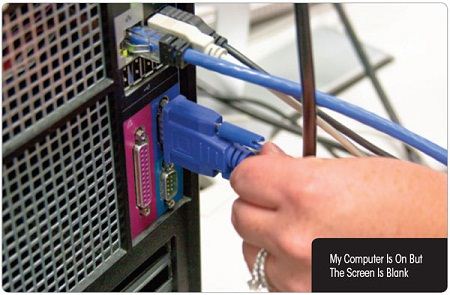
1) Unplug the monitor’s power cable from the monitor (and the wall outlet) and then plug the cable back in. Also, make sure the video cable is firmly connected to your computer and the monitor. Reconnect any unplugged or loose cables.
2) Is there a small colored light illuminated in the corner of your monitor? If not, push the Power button to turn it on.
3) Open the monitor’s Brightness Settings. To do so, find the button on the front of the monitor that has an icon that resembles a light bulb or sun. Push it to adjust the brightness level to your desired setting. You may have to consult your monitor’s manual for help if there is no dedicated brightness button.
4) Your PC might be in Sleep or Hibernation mode. To “wake” it and view your desktop, try pressing the ENTER key, moving your mouse, and pressing the Power button.
My PC Is On But Doesn’t Recognize Commands From The Keyboard Or Mouse
Press CTRL-ALT-DELETE to access the Shut down button if your PC doesn’t respond to mouse clicks or use your mouse to shut down and restart the system if the keyboard is causing the issue.
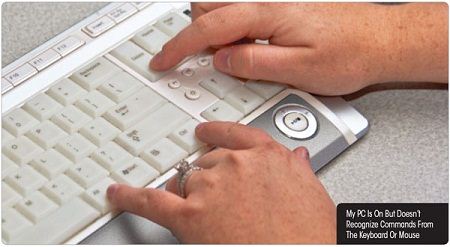
1) If your programs and applications don’t respond to the keyboard commands, use your mouse to shut down the computer. Unplug the keyboard from your PC and then reconnect it. Restart your PC to determine if the reconnection corrected the problem. (If necessary, you can press and hold the Power button to shut down the PC.)
2) If your mouse doesn’t respond, but your keyboard does, use the WINDOWS, ARROW, and ENTER keys to open the Start menu and shut down the computer. Unplug your mouse and then reconnect it. (If necessary, you can press and hold the Power button to shut down the PC.)
3) If you’re using a wireless keyboard and mouse, ensure that the peripherals are synced and in range of the wireless receiver. Install new batteries.
4) If these steps don’t enable peripheral communication with the PC, try reinstalling your device drivers. You can often download these from the manufacturer’s Web site.
My Computer Is Frozen
The Windows Task Manager helps you find programs that are not running properly.
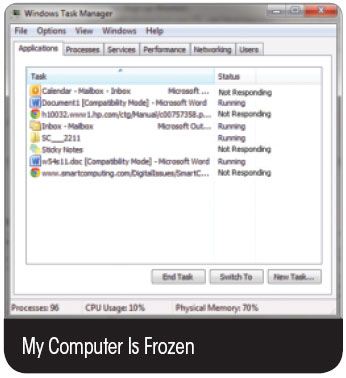
1) Press and hold the Power button until it shuts down. Wait approximately 10 seconds before you restart the system.
2) If your PC is working, but a program is frozen, press CTRLALT- DELETE and click the Start Task Manager. Select the program that is frozen and then click End Task. (The Task Manager’s Status column will probably say “Not Responding” next to that program.)
My Laptop Won’t Connect To The Internet Via Wi-Fi
If you notice a red X or yellow triangle in the Network And Sharing Center, click Troubleshoot Problems to determine the cause of the disconnection.
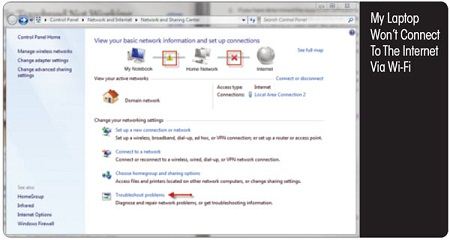
1) Locate the network icon in the bottom-right corner of the Taskbar. Right-click it and select Open Network And Sharing Center. If you see an exclamation point in a yellow triangle or a red X between your network and Internet icons, click Troubleshoot Problems. Next, click Internet Connections to run a diagnostic and follow any subsequent instructions.
2) If you have determined that the issue is not software-related, check your wireless networking hardware, which should include a broadband modem (connected by your Internet service provider to a phone or cable jack), the attached wireless router, and a power source. Ensure that all cables are properly connected and that both the modem and the router are operating normally. Consult the device manufacturer manuals for more information. If necessary, press any Reset buttons you see or unplug the power cables from both devices, wait 10 seconds, and retry.
3) If you’re trying to connect via a hotspot, you may need to enter a password. Many wireless networks are encrypted.
My Computer Doesn’t Play Any Sounds
Speakers that don’t produce sound may only need to be unmuted. To turn on the sound, click the speaker icon in the Volume slider.
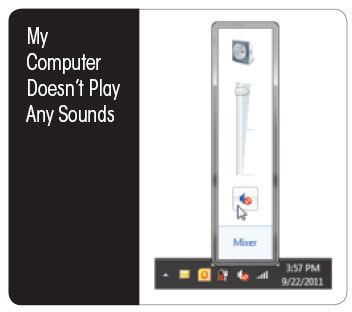
1) Locate the speaker power or volume knob on your PC or laptop. Ensure that the speakers are on and the volume is turned up and audible.
2) Click the speaker icon in the Notifications Area of the Taskbar. Click and drag the Volume slider up if it’s positioned at a low level. Also, make sure that there is no mute symbol next to the speaker under the volume slider. Click the bottom speaker icon to turn off Mute.
The Touchpad On My Laptop Doesn’t Work
When the touchpad on your laptop is unresponsive, try pressing the appropriate function key and the touchpad activation key.
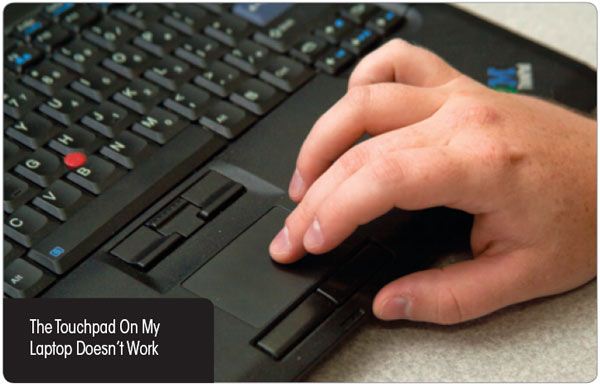
1) You can often reactivate a disabled touchpad by simply locat-ing and pressing a couple of keys. To do so, find the FN (function) key on your laptop’s keyboard. Next, locate the corresponding F key (between F1 through F12). Press FN and then press the F key. A device settings dialogue should appear and give you the option to enable your touchpad. If this doesn’t work, press both buttons simultaneously and test the touchpad again. If these steps fail to activate your touchpad, consult your laptop’s manual.
 Dinesh Thakur holds an B.C.A, MCDBA, MCSD certifications. Dinesh authors the hugely popular
Dinesh Thakur holds an B.C.A, MCDBA, MCSD certifications. Dinesh authors the hugely popular